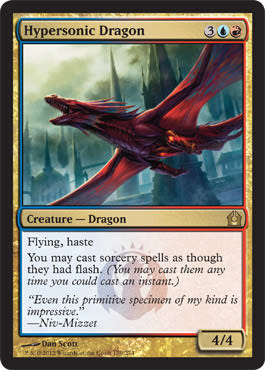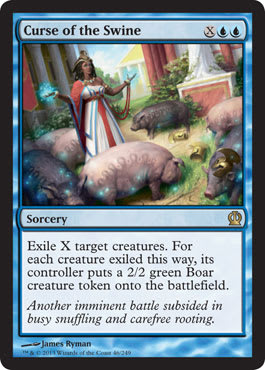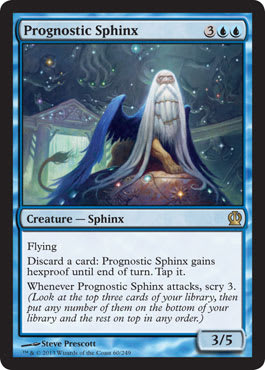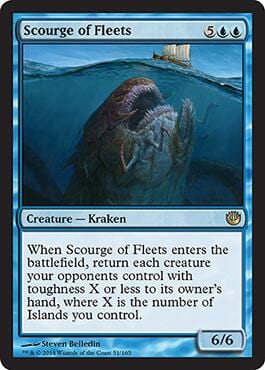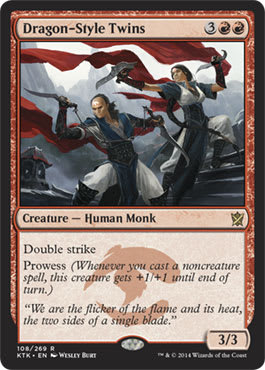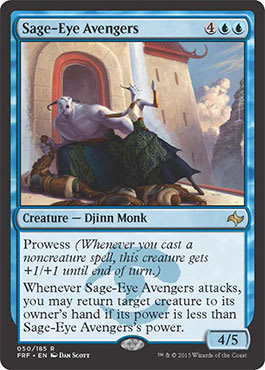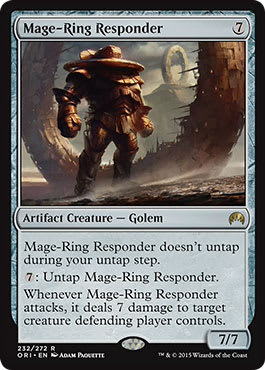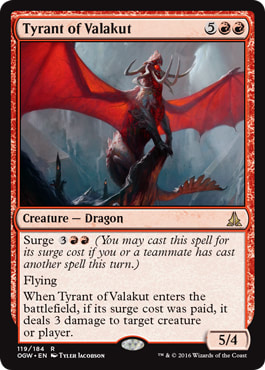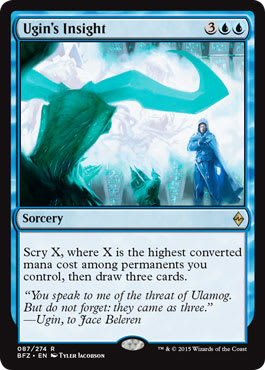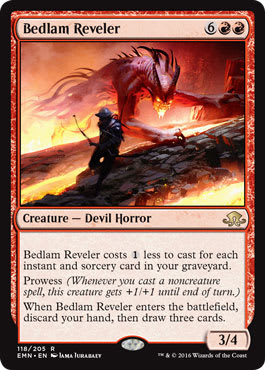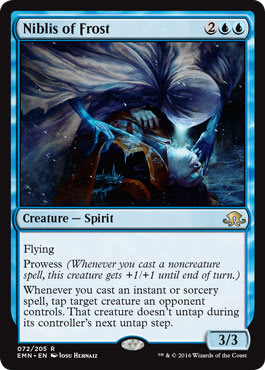Welcome back to the history of the U/R color pairing, as told in the many Intro Packs that have featured it. With the game having lasted more than two decades, it’s fascinating to see how different color abilities and philosophies have evolved over time. Preconstructed Magic — that is, decks designed by Wizards of the Coast, give us a great ability to see what was happening in the game at different periods of time.
We began last week with Pumped Up from Zendikar, and made it to Magic 2013’s Depths of Power, in a golden age for the archetype. What better place to kick things off with today than an actual Izzet Izzet deck?
Year: 2012
Deck: Izzet Ingenuity
Set: Return to Ravnica
Rares: Hypersonic Dragon, Mizzium Mortars
By this point, the U/R identity of “spells matter” had been firmly entrenched, so the composition of this deck would have come as little surprise to those who had played with Mirromancy, Eldritch Onslaught, and Depths of Power — all decks that were released within the previous eighteen months.
The formula by now was clear: field a bunch of creatures that synergized with the instant and sorcery card types, and (surprise!) a bunch of instants and sorceries. Those instants and sorceries would do the typical things you’d expect the colors to do. Red would burn things up. Blue would offer tempo, trickery, and maybe even a little permission too. Often the ground game would be a bit anemic until the deck came together, but if you were able to last as the synergies mounted, the deck could take over the game.
While that might leave the intersection of the colors feeling perhaps a touch formulaic, that doesn’t mean that it wasn’t still a lot of fun to play when constructed correctly. Izzet Ingenuity had all the pieces. You had the synergy creatures, ranging from Goblin Electromancer to Guttersnipe, which led into a Hypersonic Dragon as one of your two beefiest closing options (the other being the very plain Tenement Crasher).
The deck packed loads of burn, such as Annihilating Fire, Electrickery, and Mizzium Mortars, the latter two featuring the updated guild’s new signature mechanic, overload. This let you turn a single-target spell into one that hit all of your opponent’s creatures, just the thing to throw some fuel on the fire of you burn. Intriguingly, Red also went for token generation through Krenko's Command and Goblin Rally, with the idea being if you could nuke your opponent’s board through overloaded burn, even weenies would have a newfound relevance.
Overall, the deck was a bit fragile in the buildup — a consistent weakness in the archetype. Even the Cobblebrute’s 5 power was susceptible to being traded out for a Grizzly Bear — a poor loss of value. To get overload working you not only needed a fair amount of mana, but you needed to be able to take advantage of tempo change, which wasn’t always guaranteed, but hit-or-miss inconsistency came with the territory.
Year: 2013
Deck: Fire Surge
Set: Magic 2014
Rares: Chandra's Phoenix, Shivan Dragon
Oh look, another Shivan Dragon! Sadly for its fans, the run of “spells matter” decks came to an inglorious end with Fire Surge. Perhaps befitting a core set, this deck took us back to Magic’s fundamentals of “cast things, turn creatures sideways.”
The creature complement was nothing special, with Goblin Shortcutters, Phantom Warriors, and Regathan Firecats. Beyond another Shivan Dragon inclusion, the biggest beater here was the Fleshpulper Giant, which begged the question of just how much you’d be willing to pay for a 4/4.
The spells were everything you’ve come to expect. You had burn, from Volcanic Geyser (a nice return from Mirage/Sixth Edition) to the bland Lava Axe (three copies!). Then a bit of bounce (Disperse), counter (Essence Scatter), and card draw (Opportunity) to check Blue’s boxes. And . . . that was really about it. A “see how Blue and Red does it” deck to its very core, this one was eminently forgettable. Would a Spelltwine have been too much to ask?
Year: 2013
Deck: Manipulative Monstrosities
Set: Theros
Rares: Curse of the Swine, Shipbreaker Kraken
Manipulative Monstrosities is what you get if you take the above Fire Surge and stick a couple of mechanics on it to give it some variety. It’s no less a “see how Red and Blue does it” deck than the core set one, but the addition of scry and monstrosity at least lend some strategic depth and flavor to the deck that was sadly missing from Fire Surge. Maybe that’s the lesson here: it’s okay to be simple, as long as you’re not plain?
And so we have a deck filled with creatures, about half of whom are weenie-sized (Coral Merfolk, Archaeomancer), the rest of which are more suitably robust (Water Servant, Sealock Monster). The ability to make some of the larger creatures larger still through monstrosity gives the late-game added relevance, as a Shipbreaker Kraken or Stoneshock Giant can paralyze a defense for a game-winning alpha strike.
The “manipulative” in the deck’s name comes from the presence of scry, and while it does offer some welcome utility and decision-making, it’s still more or less a tack-on to standard effects. Burn (Volcanic Geyser, Shock), bounce (Disperse, Sea God's Revenge), and counter (Dissolve) — all you’re missing is card draw to have the “stock” U/R formula.
Year: 2014
Deck: Fates Foreseen
Set: Journey into Nyx
Rares: Prognostic Sphinx, Scourge of Fleets
Fates Foreseen was in some ways the deck that Manipulative Monstrosities wanted to be, but simply couldn’t or wouldn’t. It keeps us grounded in the realm of the creature, which we returned to with Magic 2013’s Fire Surge, but starts to creep back toward a more nuanced Izzet build. The card that sums this up best is actually an enchantment, Knowledge and Power.
Knowledge and Power brings in a Red stable card type, the mechanic-synergistic “bonus damage” enchantment. We last saw this featured in Eldritch Onslaught, which put a lot of work on the shoulders of Burning Vengeance, and it’s a welcome sight here. Fully half of the eighteen creatures offer scry to support it, and two of them (Sigiled Starfish, Stormcaller of Keranos) even offer it as a repeatable ability. Eight of the twelve spells also have the ability, so you’ll have little difficulty improving your card draw over the course of the game, with or without Knowledge and Power.
There are even a couple of subtle elements present we’ve seen in previous Izzet decks. “Spells matter” is evoked by the inclusion of Spite of Mogis and Pull from the Deep. “Converted-mana-cost matters,” which was the basis of 2003’s Pulverize Theme Deck from Scourge (see our History of Izzet Theme Decks, link here), gets a nod with Interpret the Signs.
All in all, this was a solid inclusion in the Izzet line-up, and a nice code to Theros Block after the somewhat lackluster Manipulative Monstrosities.
Year: 2014
Deck: Flames of the Dragon
Set: Magic 2015
Rares: Hoarding Dragon, Siege Dragon
Any worries that the next core set release after Fire Surge would be another regression back to the mean proved somewhat unfounded, as Flames of the Dragon carried the U/R banner for Magic 2015. There was certainly an element of “creatures and support” we’d seen in the more simplistic iterations, but there was a welcome wrinkle here in an unexpected form: artifacts!
That’s right, sandwiched between Theros Block and Khans of Tarkir was a core set with a strong artifact component, and Flames of the Dragon contains a full fourteen of them. Some of them, like the Ornithopter and Juggernaut (two cards with long pedigrees) are creatures, many others are general in nature like Sacred Armory and Tyrant's Machine, or equipment like the Rogue's Gloves or Brawler's Plate. Heck, there’s even a Darksteel Citadel.
Much of the remainder of the deck consists of cards that play into the theme, like the Aeronaut Tinkerer, Scrapyard Mongrel or the popular Ensoul Artifact. While perhaps the very opposite of the “spells matter” build as you can get, with only two sorceries and one instant (a solitary Shrapnel Blast, unsurprisingly), the artifact focus gives it a high degree of novelty making it one of the standout decks in the catalogue.
Year: 2015
Deck: Cunning Plan
Set: Fate Reforged
Rares: Dragon-Style Twins, Sage-Eye Avengers
Another interesting twist came the following year, in Fate Reforged. To this point, we’ve largely focused on the difference between “spells matter” decks, ones that contain comparatively few creatures and instead rely on synergies with instants and sorceries to punch above their weight, and the more traditional “cast beaters, support them with spells” decks that resemble for ordinary Magic.
Along come the Jeskai, who ask why can’t we have both?
Introduced in Khans of Tarkir, the Jeskai’s clan mechanic, prowess, takes the notion of creature-spell synergy and stretches it out like a blanket. As evidenced by Cunning Plan, no longer do we have to rely on creatures with individual triggers for our spells, but rather, we can have (pretty much) the entire side buff up whenever we cast them.
There isn’t a single card in the deck that references “instant or sorcery.” Rather, we see them lumped into a larger category that includes artifacts and enchantments, called “noncreature spells,” and boy do those matter here. You’ve got prowess triggers on every creature in the army except two, the Welkin Tern and Aven Surveyor.
To back up this go-wide approach, you’ve got nearly as many non-creature spells, including two more doses of synergy in Quiet Contemplation and Goblinslide. For all this, the deck can tend to fall a bit flat. Prowess tends to keep the creatures a bit lower in terms of power, so unless you’re casting spells you’re often stuck with an army of weenies. There’s a decent burn suite, but Blue’s contribution is mainly limited to tapping things (a fine, but temporary measure) and drawing cards. Still, the prowess mechanic was not only popular amongst players, but also a notable attempt to forge a new direction in U/R relations.
Year: 2015
Deck: Assemble Victory
Set: Magic Origins
Rares: Mage-Ring Responder, Pia and Kiran Nalaar
We know now that the emphasis on Ghirapur in Magic Origins was a set-up for Kaladesh, so it shouldn’t be any surprise that the artifact-heavy deck we saw in the previous core set (Flames of the Dragon) found a successor in Magic Origins. While it carries nearly the same number of artifacts (thirteen versus fourteen), it takes a different approach on how the rest of the creatures embrace the theme. In Flames of the Dragon, some of your creatures “powered up” when you had an artifact in play. Here, cards like Whirler Rogue and Thopter Engineer bring their own artifacts along with them!
The deck drops the equipment contingent, and focuses mainly on artifact creatures like Bonded Construct and Ramroller. Build up enough of them, as well as the 1/1 Thopter tokens, and you can begin to channel that into direct damage through Reclusive Artificer, Ghirapur Aether Grid or Pia and Kiran Nalaar. The deck packs a very dense twenty-four creatures (not including the Thopters many of them generate), so ultimately it wants to overwhelm your opponent with them as a primary victory condition.
Overall, this was a solid take on the U/R archetype, with the artifact theme giving a very fresh coat of paint to the standard “creature swarm” deck. Between these and prowess, one could begin to wonder, however, if “spells matter” might have been taking a shift off.
Year: 2016
Deck: Surge of Resistance
Set: Oath of the Gatewatch
Rares: Tyrant of Valakut, Ugin's Insight
Or maybe not! Just as prowess was a creative twist on making spells relevant beyond the effects they provided, the surge mechanic — which let you cast spells at a discount if you’d already cast a spell that turn — was another new way to for spells to shine. Just as with Cunning Plan, the twenty creatures carried the burden of work.
Indeed, in many ways looking at this deck was like seeing the evolution of previous Izzet decks in the DNA. Several of these carried the now-evergreen prowess, like Stormchaser Mage and Umara Entangler. Other creatures took advantage of surge to offer discounts in their casting, like the Jwar Isle Avenger and Reckless Bushwhacker. And for that flavorful callback, there was even repeatable scry with the Windrider Patrol.
As for the spells, the usual suspects were well represented. Burn had Rolling Thunder (like Volcanic Geyser, a delightful reprint from an earlier era) and Boulder Salvo. Bounce came from Roiling Waters, and card draw in the forms of Comparative Analysis and Ugin's Insight. This time, it was permission that was left behind, but the deck didn’t seem to miss it.
And again, a Red mechanic-based damage-dealing enchantment in the form of the Pyromancer's Assault to reward you for playing the deck the way it wanted to be played. Although not an all-time classic, Surge of Resistance is nevertheless a standout, particularly in a set that had some pedestrian offerings in the Intro Pack selection.
Year: 2016
Deck: Dangerous Knowledge
Set: Eldritch Moon
Rares: Bedlam Reveler, Niblis of Frost
For the final Izzet Intro Pack before the product line’s discontinuance, we get to end on a high note — a full-on, high octane “spells matter” deck to see us out. Dangerous Knowledge scaled back the creatures, letting instants and sorceries shine in the spotlight. And shine they do!
For one thing, there’s a trio each of Galvanic Bombardment and Take Inventory, cards using the “Kindle” mechanic that makes them more powerful the more you’ve played. There’s plenty more burn to go around, from Incendiary Flow to Reduce to Ashes to Geistblast and more. Card draw? You bet. Beyond the Take Inventorys, you’ve got the flavorful Pieces of the Puzzle and Pore over the Pages. Bounce? No problem! Drag Under at your service. And this time, the permission wasn’t neglected, as evidenced by Convolute and Turn Aside.
More than that, you had spells that synergized with your instants and sorceries. Rise from the Tides gave you Zombies, while Shreds of Sanity could return up to two from your graveyard. And the synergies continued right throughout the creature base, with Thermo-Alchemist, Weaver of Lightning, and Mercurial Geists adding extra effects each time you cast your spells. It’s unusual for both rares to so directly synergize with the deck, but Bedlam Reveler and Niblis of Frost both offered team play.
In short, the “spells matter” theme that really began in the Intro Packs with Mirrodin Besieged’s Mirromancy came to full fruit in the end. Dangerous Knowledge was a delight, and an Izzet deck to remember.
I hope you’ve enjoyed our walk through Magic’s history with the Izzet. Are there any decks you’ve played that particularly stand out to you? I’d love to hear some in the comments!













